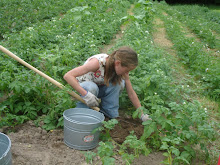

Last April I bought two sheep and a goat at a livestock auction. Both of the sheep are interesting specimens. Phyllis is a tall sheep with a grey face and legs, white wool and small horns. She weighed 175 pounds (wool included) when I bought her. Phyllis’ pal, Marilyn is a hair sheep, meaning that instead of wool she grows hair. Marilyn weighed in at 75 pounds when I bought her and is really a beautiful animal. She’s light brown on top with black markings, no horns and big, pretty yellow-brown eyes.
My husband, Cass and I unloaded these three critters into a pen in our barn. With the pasture that we had earlier fenced off for them quickly greening up we knew we had to shear Phyllis reasonably soon (we figured it would be easier to catch a somewhat skittish 175 pound sheep in a pen rather than in a two-acre pasture).
Cass and I had never shorn a sheep before nor had we ever actually observed a sheep being shorn. We started reading up on it. From what we gathered all we had to do was: spread a tarp down in a small pen (this would catch the wool and keep it from getting dirty); get the sheep to stand on the tarp; position the sheep between our knees on it’s back or side; use a clippers or scissors to first trim off any dingleberries or dread locks, discard these; and finally proceed to clipping the fleece starting at the animal’s head and clipping in wide sweeps across the body until you get to the bottom. The fleece should come off in one neat piece leaving a nicely groomed looking sheep in its wake.
The whole procedure seemed pretty straightforward and Cass and I figured we could probably de-fleece Phyllis in maybe 15 minutes (since we were inexperienced, an experienced sheep shearer could probably do it in 5). I thought to myself, hell, I could probably have half a scarf crocheted of Phyllis’ fine wool by the end of this evening.
I called my parents, who live just down the road, to set up some day care for our then seven month old son. They said they’d be more than happy to come up and watch the festivities. They showed up with a camera and an extra pair of scissors.
Cass and I were pretty certain that this was not Phyllis’ first rodeo (according to our readings sheep that have been sheared in the past are not really all that opposed to it). So we sauntered into the pen reasonably confident that we could easily herd Phyllis into the prearranged sheep shearing area that we had prepared.
Phyllis was simultaneously onto us and unimpressed with our herding abilities. She easily side-stepped us, carefully avoiding the open gate that led into the shearing area. As a result, we soon learned that this was going to be a more hands on kind of job than we had previously thought. We commenced tackling Phyllis. My husband and I are not very large people. Phyllis outweighed each of us by about 45 pounds plus she’s a way better wrestler than either of us could ever hope to be.
After some serious wrestling and few choice words that had nothing to do with sheep shearing, Cass managed to secure Phyllis in a head lock (I use the term “secure” loosely here). Really Cass just had a hold of her neck and he was leaning back and trying to put the brakes on while Phyllis, obviously the one in control here, trotted around the pen in apparent denial of her need for a haircut.
I chased this Cass-Phyllis train along with Marilyn and the goat for a few turns. I finally got my bearings and started bringing up the caboose by grabbing onto Phyllis’ hind end. I started pushing her and to the best of my ability also steering her. Between the two of us Cass and I managed to steer/drag Phyllis to the sheep shearing area.
Right away we learned that there were a few problems with our shearing set-up. First off, Phyllis was terrified of the tarp we had spread on the floor and actually started bucking. “Whoa, whoa, whoa, whoa, whoa,” hollered my husband as Phyllis thrashed him up and down. “Let ‘er go,” I hollered back as I released my end and frantically started kicking the tarp out of Phyllis’ way.
A second problem with out set-up was that Marilyn and Phyllis could see each other through the gate and were experiencing severe separation anxiety. They let us know how distressed they were by adding their deep, sad bleats to the general chaos.
Realizing that shearing Phyllis (wouldn’t ‘Shearing Phyllis’ be a great name for a band?) was going to be more complex than we originally expected, but knowing we had to press on, Cass moved onto the next step which was; position the sheep between your knees. This act of bravery earned Cass more than one sheep ride around the pen.
At this point we decided to discard everything we had ever learned about sheep shearing (which wasn’t much) and develop our own method. Our method was this; hold Phyllis down anyway you can and clip her wool in any manner possible. My dad hopped into the pen and helped us out. Throughout the next hour the three of us managed to hold Phyllis down in many ways (at one particularly hectic point we even had her hog tied) and clip copious amounts of wool off in a willy-nilly fashion.
When it was finally finished, Phyllis looked reasonably shorn. Examining the tangled mass of wool lying haphazardly on the floor I decided that since it was already April I really didn’t need a new scarf after all.



